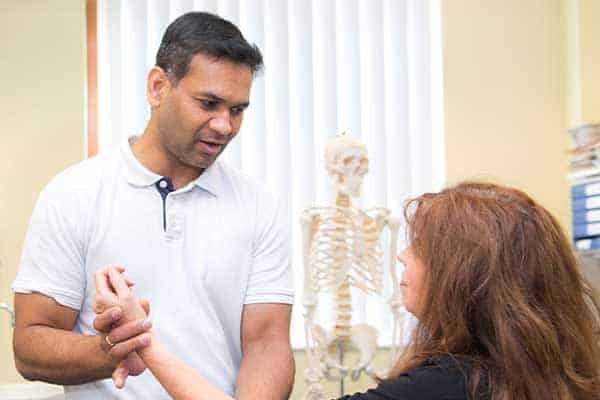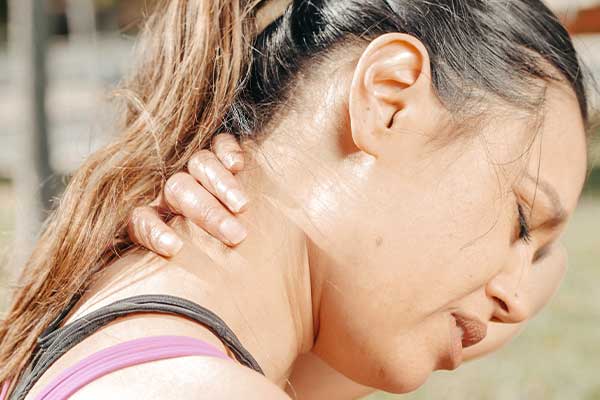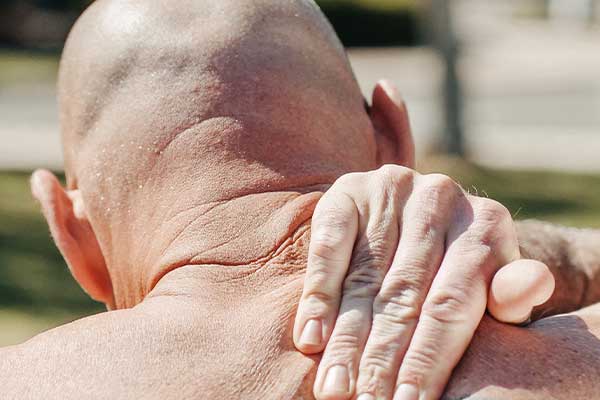Nerve-related neck and arm pain is a term for the symptoms experienced when you have an irritation or injury of the nerves that run from the neck and down the arm. Nerve-related neck and arm pain has also inaccurately been called a ‘slipped disc’.
What causes nerve-related neck and arm pain?
Nerve-related neck and arm pain is typically caused by changes in the discs or other structures near where the nerves come out of your neck. The disc does not actually ‘slip’ but part of it can bulge out and compress a nerve.
What are the symptoms of nerve-related neck and arm pain?
Nerve-related neck and arm pain is not linked to a trauma such as a fall or an impact. When it first appears, it might be sharp or dull, tingling or buzzing, and can feel like an electric shock.
Common symptoms can include:
- A gradual onset of pain in your neck, often into your arm down to your hand.
- The pain causes reduced range of movement in your neck.
- Referred pain in your shoulder or upper back.
- Pins & needles, loss of feeling or muscle weakness in your arm and/or hand.
How is nerve-related neck and arm pain diagnosed?
If you have not experienced these symptoms previously, you are advised to seek advice from your GP or physiotherapist. They will be able to assess your condition.
What are the treatment options for nerve-related neck and arm pain?
Although you may wish to take it easy while you establish how best to manage your pain, do not be over-cautious. You are safe to move and will not cause further damage.
If you keep moving, and control your pain, you should be able to build back into your normal daily routine.
You could try some simple stretching and mobility exercises to help maintain the health of your neck. Choose the most comfortable exercise for you and build up slowly through the others, avoiding anything that makes your symptoms get worse.
You could also apply gentle heat or ice, which can help to manage the pain. (Do not put ice directly next to skin as it may cause ice burn. Wrap it in a damp tea towel.)
Paracetamol-based painkillers can help by enabling you to continue with your normal activities. Anti-inflammatory painkillers such as Ibuprofen can also be helpful in reducing pain. You could also ask your GP or pharmacist about specific nerve pain medication.
Controlling pain is also important for getting a good night’s sleep, which can be an important factor in your recovery.
In a minority of cases, if your symptoms persist your doctor may offer you other treatments, including injections or surgery.
What is the prognosis (outlook) for nerve-related neck and arm pain?
If properly managed and treated, nerve-related neck and arm pain should settle down by itself in most cases. For less severe cases, the symptoms will often clear up within 6-8 weeks, while more severe cases may take longer.
However, you should seek medical advice if the pain gets much worse or if you experience the following:
- Pins & needles and numbness increasing in both arms at the same time.
- Unsteady walking.
- Dizziness and/or fainting.
- Double vision.
- Trouble swallowing food.
How can I prevent recurrence of nerve-related neck and arm pain?
Once the symptoms of nerve-related neck and arm pain have gone away, it is beneficial to continue with your exercises and with an active lifestyle in general.
Avoid keeping your neck in the same position for a long time. Maintain a good posture and also remember to change your position regularly.
Use a firm mattress to sleep on and try to ensure that your head is at the same height as your body.
Recommended exercises (click to expand):
Isometric neck
- Sit on an upright chair or stool, looking straight ahead.
- Place the palm of one hand against your forehead, then gently push your head against your hand and hold.
- Place your hand on the back of your head, push your head against your hand and hold.
- Place your hand on the side of your head, gently push your head against your hand and hold.
- Place your other hand on the other side of your head, gently push your head against your hand and hold.
Towel rotation
- Sit in an upright chair with a short rolled-up towel behind your neck and the ends on your chest.
- Take the left end of the towel in your right hand and the right end in your left.
- Hold your hands up in front of your neck (now your hands are not crossed over but the towel ends are).
- Rotate your head to the right while moving your right hand in the same direction, pulling the towel tight.
- Gently turn your head and right hand back and forth to the right. Your left hand should stay still.
- Repeat on the other side.
Towel extension
- Sit in an upright chair with a medium-long rolled-up towel behind your neck and the ends in your hands.
- Tilt your head to look up towards the ceiling and at the same time pull forwards away from you on the ends of the towel.
- Repeat this extension or move the towel slightly upwards or downwards on your neck to find different points to stretch at.
Neck flexion, extension, sidebending and rotation
- Sit up straight with your shoulders back and down, looking straight ahead.
- Tilt your head to look down towards the floor.
- Tilt your head to look up towards the ceiling.
- Turn your head to look over your right shoulder.
- Turn your head to look over your left shoulder.
- Move your right ear towards your right shoulder.
- Move your left ear towards your left shoulder.
- Keep your shoulders down at all times.





